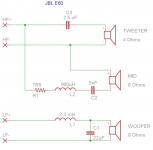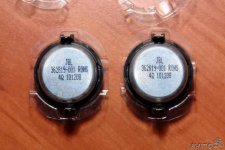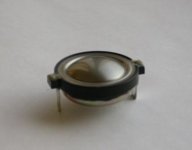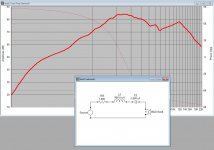Hi There!
I'm about to make an adaptation using the excellent Beyma T2010 tweeters on my Northridge E60 JBL Speakers.
After some stupid abuse, I've blown the original tweeters. OK, sh*** happens, but I was surprised when I removed the cover and I found a very small tweeter in there, which was 4-Ohms! Digging deeper, I found more weird things. The crossover for the TW is just a 2.5uF capacitor, that if I'm correct, will provide a 16khz cut 6Db/oct for a 4Ohms driver. The owner manual says that the crossover frequencies are 1000 Hz and 4000 Hz. So, what the heck?!
I've attached the crossover schematic, it is 100% reliable as I drew it myself and I measured the inductors. I couldn't figure out the frequencies, neither the type myself. I was hoping that you could help me figure that out!
By the way, why would the tweeter be 4Ohms if the rest is 8Ohms?
Why would the midrange be inversed?
What are the actual xover frequencies and type?
Thank you very much!
Best Regards
I'm about to make an adaptation using the excellent Beyma T2010 tweeters on my Northridge E60 JBL Speakers.
After some stupid abuse, I've blown the original tweeters. OK, sh*** happens, but I was surprised when I removed the cover and I found a very small tweeter in there, which was 4-Ohms! Digging deeper, I found more weird things. The crossover for the TW is just a 2.5uF capacitor, that if I'm correct, will provide a 16khz cut 6Db/oct for a 4Ohms driver. The owner manual says that the crossover frequencies are 1000 Hz and 4000 Hz. So, what the heck?!
I've attached the crossover schematic, it is 100% reliable as I drew it myself and I measured the inductors. I couldn't figure out the frequencies, neither the type myself. I was hoping that you could help me figure that out!
By the way, why would the tweeter be 4Ohms if the rest is 8Ohms?
Why would the midrange be inversed?
What are the actual xover frequencies and type?
Thank you very much!
Best Regards
Attachments
Maybe this is the answer to your question:
JBL E60 quick review
JBL E60 quick review
An externally hosted image should be here but it was not working when we last tested it.
Yes, it did! Basically the E60s are crippled from factory by a shocking bad crossover. The Mid isn't there because of a 7R5 attenuation resistor. There's a lot to work on them, but they really have potential to sound awesome! Will just require a measurement tool and time to work on it.
I think the majority of inexpensive manufacturers use crossovers like this, I've got a pair of Cerwin Vega 3 ways in the basement that have I think 4 or 5 parts (if you count the fuse) on the crossover that's glued to the terminal cup, and another pair of Altec Lansing outdoor-type speakers that I'm using for my surround-back left and right that have only a capacitor on the tweeter if I remember right.
Yeah... But 4-Ohms tweeter is really TOO BAD!
I don't get what you mean, lots of superb tweeters are 4 ohms.
In a 8-Ohms loudspeaker?
Sure, the speaker can be labeled as 8 ohm nominal impedance, but at any given frequency the impedance moves around quite a bit. Chances are the amount of the frequency spectrum that the tweeter covers in a 3 way wasn't significant enough to change their rated average impedance.
They probably just got a better deal on the 4 ohm version and figured it wouldn't alter the average impedance enough to be of concern.
Yeah, but they were receiving twice the power, consequently, they toasted.
Anyway, apart from that, I would like to show you all how the E60 are "capped" of its true potential. Attached are the service manuals of borth E60 and E80 loudspeakers. You can observe that the Mid-range and Tweeters are the SAME for both. The only difference is that the E80 uses 2x 6" woofers instead of 1x 8" of the E60. Anyway, that does not justify the HUGE crossover difference.
The E60's manual claims that the crossover frequencies are 1000 and 4000Hz. CLEARLY the crossover frequency of the tweeter is not 4k, but it is 16k, as it uses a 2.5uF cap on a 4-Ohms tweeter.
The Mid-Range is too much attenuated with a 7R5 resistor, that's why it has reviewed as pointed out from our friend erjee:
I think I'll hear a GREAT improvement!
 Copyrighted material removed. Posting copyrighted material without the permission of the copyright holder is against forum rules. Either post a link to the original material or create your own document with the relevant information.
Copyrighted material removed. Posting copyrighted material without the permission of the copyright holder is against forum rules. Either post a link to the original material or create your own document with the relevant information.
Anyway, apart from that, I would like to show you all how the E60 are "capped" of its true potential. Attached are the service manuals of borth E60 and E80 loudspeakers. You can observe that the Mid-range and Tweeters are the SAME for both. The only difference is that the E80 uses 2x 6" woofers instead of 1x 8" of the E60. Anyway, that does not justify the HUGE crossover difference.
The E60's manual claims that the crossover frequencies are 1000 and 4000Hz. CLEARLY the crossover frequency of the tweeter is not 4k, but it is 16k, as it uses a 2.5uF cap on a 4-Ohms tweeter.
The Mid-Range is too much attenuated with a 7R5 resistor, that's why it has reviewed as pointed out from our friend erjee:
Anyway, I'll build a crossover similar to the E80's but with an additional 2Db attenuation for the mid-rage, to couple with the E60's lower sensitivity single woofer. The tweeter Will be the Beyma T2010 which is EXCELLENT, attenuated in 3Db (from 92Db to 89Db), so it couples with the rest.While it feels like JBL has great smooth and powerful bass and are perhaps more detailed then Athenas at the high end they totaly lack any sort of midrange. It's so muted with the E60, it simply isn't there and that takes away the joy of listening to anything that has any midrange.
I think I'll hear a GREAT improvement!
 Copyrighted material removed. Posting copyrighted material without the permission of the copyright holder is against forum rules. Either post a link to the original material or create your own document with the relevant information.
Copyrighted material removed. Posting copyrighted material without the permission of the copyright holder is against forum rules. Either post a link to the original material or create your own document with the relevant information.The E60's manual claims that the crossover frequencies are 1000 and 4000Hz. CLEARLY the crossover frequency of the tweeter is not 4k, but it is 16k, as it uses a 2.5uF cap on a 4-Ohms tweeter.
You can't be certain without seeing the impedance and frequency curves of the tweeter rather than just it's nominal value. It's nearly impossible to look at crossover values and then try to know the crossover frequency knowing only nominal impedance.
The crossover frequency of the tweeter may very well be 4khz if the impedance of the driver in that range is high enough.
You'd have to measure the drivers frequency response and impedance curves to know for sure, simply changing the crossover component based on the nominal impedance airbrushed on the back of the magnet probably won't yield very good results at all.
I fully agree with you, but to cut at 4Khz, the impedance has to drift 4 times up. Do you think that is possible?
The E60 has just a 2.5uF capacitor in series with the tweeter.
The E80 has a 1.5R resistor + 5.1uF capacitor in series with the tweeter, plus, a 0.12mH inductor across it.
Tweeters are the same and both claimed crossover frequencies are 4Khz.
I'm really confused here!
The E60 has just a 2.5uF capacitor in series with the tweeter.
The E80 has a 1.5R resistor + 5.1uF capacitor in series with the tweeter, plus, a 0.12mH inductor across it.
Tweeters are the same and both claimed crossover frequencies are 4Khz.
I'm really confused here!
Speakers are not resistors, they have varying impedance and inductance at different frequencies.I fully agree with you, but to cut at 4Khz, the impedance has to drift 4 times up. Do you think that is possible?
The E60 has just a 2.5uF capacitor in series with the tweeter.
The E80 has a 1.5R resistor + 5.1uF capacitor in series with the tweeter, plus, a 0.12mH inductor across it.
Tweeters are the same and both claimed crossover frequencies are 4Khz.
I'm really confused here!
Your confusion stems from not realizing that the acoustic crossover is usually vastly different from what the electrical crossover using a fixed impedance model would predict.
Perhaps I'm confused here, but I ran the values of the midrange (0.9mH and 5µF) into a crossover calculator, and came up with completely Daft results.
The 0.9mH creates a 1.4khz Low Pass Filter.
The 5µF creates a 4khz High Pass Filter.
Shouldn't that be the opposite? Hasn't this created a midrange band BLOCK, rather than a midrange band PASS?
Using the same calculator, it would seem the right values would be
1.4khz = 14µF High Pass
4.0khz = 0.3mH Low Pass
Maybe my brain isn't working quite right today, and there is something obvious that just isn't penetrating.
Here is the Crossover Calculator that I used -
Crossover Design Chart and Inductance vs. Frequency Calculator(Low-pass)
I set the impedance to 8 ohms, and changed the frequencies until I got the values in the crossover. 4khz = 5µF; 1.4khz = 0.9mH.
What am I missing?
Also, though the question was asked, I don't believe it was answered. No, it is not uncommon for the midrange to be wired backwards. It has to do with phase shift caused by the crossover components. It is actually very common.
Steve/bluewizard
The 0.9mH creates a 1.4khz Low Pass Filter.
The 5µF creates a 4khz High Pass Filter.
Shouldn't that be the opposite? Hasn't this created a midrange band BLOCK, rather than a midrange band PASS?
Using the same calculator, it would seem the right values would be
1.4khz = 14µF High Pass
4.0khz = 0.3mH Low Pass
Maybe my brain isn't working quite right today, and there is something obvious that just isn't penetrating.
Here is the Crossover Calculator that I used -
Crossover Design Chart and Inductance vs. Frequency Calculator(Low-pass)
I set the impedance to 8 ohms, and changed the frequencies until I got the values in the crossover. 4khz = 5µF; 1.4khz = 0.9mH.
What am I missing?
Also, though the question was asked, I don't believe it was answered. No, it is not uncommon for the midrange to be wired backwards. It has to do with phase shift caused by the crossover components. It is actually very common.
Steve/bluewizard
Last edited:
I set the impedance to 8 ohms...
This could potentially be the problem.
It's been said a few times, but I think it bears repeating. Speakers are not resistors. They have sliding values for resistance based on frequency.
If you really want to see what these crossover parts are actually doing, you'd need to load the frequency and impedance graphs into a loudspeaker modeling program. You can't plug the crossover component values into a spreadsheet that's assuming it's driving a resistor (8 ohm resistor in this case) and expect a result that looks anything like a correct frequency response.
I've noticed over the years that if a speaker manufacturer builds its own drivers (like JBL does for example), there's a lot higher chance the crossover used will be simpler - and in Crossover Land  that's a good thing - than a company that outsources them. That's because they have the luxury of building a woofer/mid/tweeter to the exact specs they want for a specific system, so unlike many of those systems with outsourced drivers, they don't have to use the xover to correct any operating anomalies a "generic" system of drivers might generate.
that's a good thing - than a company that outsources them. That's because they have the luxury of building a woofer/mid/tweeter to the exact specs they want for a specific system, so unlike many of those systems with outsourced drivers, they don't have to use the xover to correct any operating anomalies a "generic" system of drivers might generate.
If you dig around the following site which also deals in rebuilding vintage speakers (I have no connection with the owner of that site), specifically the EPI and Genesis portions, you'll see quite a few speakers that use 6dB/octave xovers with frighteningly low xover points....well, obviously at 6dB per octave it won't be a point but slooooow downward curve.
low xover points....well, obviously at 6dB per octave it won't be a point but slooooow downward curve.
BTW for the young whippersnappers out there: yes even "back then" they knew all about 12dB, 18dB, etc per octave crossovers along with their various inductors, resistors and caps*, it's just that for some companies simple was their design philisophy, particularly those trying to build high value speakers for audiophiles on a budget.
out there: yes even "back then" they knew all about 12dB, 18dB, etc per octave crossovers along with their various inductors, resistors and caps*, it's just that for some companies simple was their design philisophy, particularly those trying to build high value speakers for audiophiles on a budget.
One of the most successful speakers sold in the 70s and one that many audiophiles back then loved to hate, was the JBL Century L100. It also used a single cap for the tweeter......and the midrange! Same situation with the extremely popular Dynaco A25 which was a two-way that used a 10" woofer and 1.5" dome tweeter (IIRC both supplied by SEAS). The woofer was connected directly to the input terminal plate i.e. no electrical xover at all, but due to its construction the proper acoustic roll-off was produced so it blended decently with the tweeter, and saved quite a bit of $$ in the process.
* if you want to see a very sophisticated xover designed in the 70s, do a search for the classic LS3/5A designed by the BBC and KEF
If you dig around the following site which also deals in rebuilding vintage speakers (I have no connection with the owner of that site), specifically the EPI and Genesis portions, you'll see quite a few speakers that use 6dB/octave xovers with frighteningly
BTW for the young whippersnappers
One of the most successful speakers sold in the 70s and one that many audiophiles back then loved to hate, was the JBL Century L100. It also used a single cap for the tweeter......and the midrange! Same situation with the extremely popular Dynaco A25 which was a two-way that used a 10" woofer and 1.5" dome tweeter (IIRC both supplied by SEAS). The woofer was connected directly to the input terminal plate i.e. no electrical xover at all, but due to its construction the proper acoustic roll-off was produced so it blended decently with the tweeter, and saved quite a bit of $$ in the process.
* if you want to see a very sophisticated xover designed in the 70s, do a search for the classic LS3/5A designed by the BBC and KEF
Last edited:
This could potentially be the problem.
It's been said a few times, but I think it bears repeating. Speakers are not resistors. They have sliding values for resistance based on frequency.
If you really want to see what these crossover parts are actually doing, ...
No one would deny that a speaker has a complex impedance pattern, but this is a cone midrange, and should be reasonably stable in its working range. The Resonance point is likely far below 1.4khz, and at a mere 4khz, the impedance probably has not risen significantly. So, 8 ohms hits it pretty close.
Plus, it is a BAND BLOCK not a Band PASS. That's pretty hard to over look, regardless of an variations in the impedance.
Steve/bluewizard
Last edited:
To the original poster,
In a previous post, I mentioned putting felt around, around not on, the tweeter.
As it happens River757 has provided a link to the JBL Century L100 speaker, go to the link and take a close look at the tweeter, and you will see a perfect illustration of what I meant -
Link to JBL Century L100 Speaker
Close up Photo of the JBL Century L100 Speaker
Steve/bluewizard
In a previous post, I mentioned putting felt around, around not on, the tweeter.
As it happens River757 has provided a link to the JBL Century L100 speaker, go to the link and take a close look at the tweeter, and you will see a perfect illustration of what I meant -
Link to JBL Century L100 Speaker
Close up Photo of the JBL Century L100 Speaker
Steve/bluewizard
No one would deny that a speaker has a complex impedance pattern, but this is a cone midrange, and should be reasonably stable in its working range. The Resonance point is likely far below 1.4khz, and at a mere 4khz, the impedance probably has not risen significantly. So, 8 ohms hits it pretty close.
Plus, it is a BAND BLOCK not a Band PASS. That's pretty hard to over look, regardless of an variations in the impedance.
Steve/bluewizard
Oh, electricity, you so crazy.
Attachments
- Status
- This old topic is closed. If you want to reopen this topic, contact a moderator using the "Report Post" button.
- Home
- Loudspeakers
- Multi-Way
- JBL E60 very strange crossover



